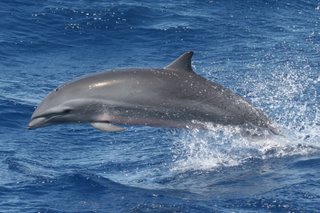Hello there, Tom Jefferson here. I have been in Hong Kong for the past month or so, conducting research on Indo-Pacific humpback dolphins (Sousa chinensis). Team 3 members will remember that I have been working on these dolphins for almost 12 years. We have learned a great deal about these dolphins over the past decade, but there are still some important conservation questions that remain unresolved. One of these is: How are the high levels of pesticides and other organochlorines in the dolphins' environment affecting their health and survival?
To answer that question, we have crafted a program in which we collect small bits of skin and blubber from living dolphins by using a crossbow and lightweight darts that are designed to only penetrate about an inch into the dolphins' bodies. These biopsy samples can tell us much.

So, for the past few weeks I have been spending my days out on the water searching for dolphins and attempting to collect biopsy samples when we see them. Weather problems, and the unpredictability of dolphin behavior have made things more difficult than originally expected. We have only been able to collect 9 samples in as many days at sea. We are hoping that our luck will improve and we can collect most of our remaining 14 samples in the next 10 days or so. Wish us luck…
Since heading overseas, I also have also done a side-trip from Hong Kong. I spent 12 days in the Maldives (for those of you who don't know where that is, look at a world map or globe and search just southwest of the tip of India). This Indian Ocean country consists of several hundred islands perched on low coral atolls - the highest point in the country is only 10 feet above sea level. Obviously, Maldivians are quite concerned about global warming and subsequent sea-level rise!!
In the Maldives we searched for whales and dolphin every day, and found a wide variety of species - spinner dolphins, spotted dolphins, striped dolphins, common bottlenose dolphins (same species as our friends in Monterey Bay… ), Blainville's beaked whales, dwarf sperm whales, and sperm whales. We even had the first confirmed record of the Indo-Pacific bottlenose dolphin in the Maldives! But, the highlight of the trip, to be sure, was the sighting of two large (200+) schools of Fraser's dolphins. This is a species of dolphin that was virtually unknown until
 1973, when the first specimens were examined, allowing us to finally know what it looked like. Previous to that it was only known from a single skull in the British Museum of Natural History. It turns out that the species is not really rare, but there is still quite a bit of mystery about it. The photograph shows the short beak, tiny dorsal fin and flippers, and unique color patttern that characterize the species.
1973, when the first specimens were examined, allowing us to finally know what it looked like. Previous to that it was only known from a single skull in the British Museum of Natural History. It turns out that the species is not really rare, but there is still quite a bit of mystery about it. The photograph shows the short beak, tiny dorsal fin and flippers, and unique color patttern that characterize the species.Although the work that we are doing in Asia may seem more exotic than Monterey Bay, we are actually using many of the same research techniques, and there are some interesting similarities. Perhaps some of the lessons we learn will help us next year in Monterey Bay!
Live well,
Tom
No comments:
Post a Comment